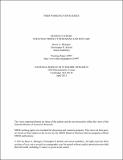Keeping it fresh: Strategic product redesigns and welfare
Author(s)
Blonigen, Bruce A.; Soderbery, Anson; Knittel, Christopher Roland
DownloadSubmitted version (914.7Kb)
Terms of use
Metadata
Show full item recordAbstract
Product redesigns happen across virtually all types of products, yet there is little evidence on the market and welfare effects of redesigns. We develop a model of redesign decisions in a dynamic oligopoly model and use it to analyze redesign activity in the U.S. automobile market. We find automobile model redesigns are frequent despite an estimated average cost around $1 billion. Our estimates also suggest that redesigns lead to large increases in profits and welfare due to the strong preferences consumers have for redesigns. We show that welfare would be improved if redesign competition were reduced, allowing redesign activity to be more responsive to the planned obsolescence channel. The net effect of these changes would reduce total redesigns by roughly 10%, increasing total welfare by roughly 3%. The high valuation that consumers put on newly-designed models drives frequent redesigns and gives automobile manufacturers fairly substantial market power, with a 2-to-1 ratio of firm profits to consumer surplus.
Date issued
2017-07Department
Sloan School of ManagementJournal
International Journal of Industrial Organization
Publisher
Elsevier BV
Citation
Blonigen, Bruce A. et al. "Keeping it fresh: Strategic product redesigns and welfare." International Journal of Industrial Organization 53 (July 2017): 170-214 © 2017 Elsevier B.V.
Version: Original manuscript
ISSN
0167-7187